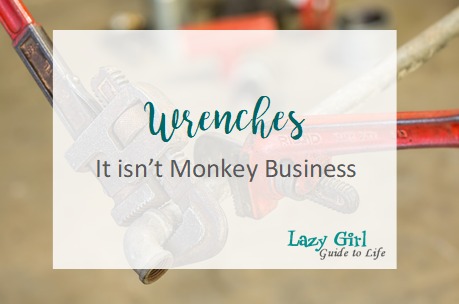Wrenches are another useful tool to have in your Lazy-Girl toolbox. There are many wrenches to choose from. They all tighten and loosen nuts, but which one or ones should I have in my toolbox? When would I use a wrench? They’re needed for working on cars and bicycles, plumbing around the house (e.g. faucets and toilets) and objects held together with bolts.
Types of Wrenches
| – Allen | · Socket | · Torque |
| · Adjustable | · Monkey | · Strap |
| · Open-End | · Oil Filter | |
| · Box-End | · 4 -Way Lug | |
| · Combination | · Pipe |
Allen Wrenches (aka Hex Keys)
If you have purchased a computer desk, bookcase or other put-together furniture, you most like have at least one wrench on hand. The hex key (also known as the Allen wrench, a registered trademark) is usually L-shaped or possibly Z-shaped. It is small, lightweight and easy to use. In fact, it’s so easy you can use either end! There are six contact surfaces between bolt and driver (“hexa” means six).
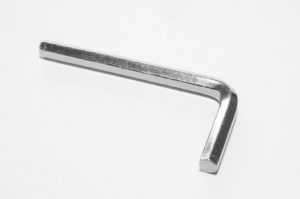
The tool can be used with a headless screw and the screw can be inserted into its hole using the key. If you assembled a piece of furniture using the hex key you may have noticed that the screws are not bulging and noticeable.
Adjustable Wrenches
Did you know that there really is a monkey wrench – that it isn’t just an imaginary tool of destruction, overthrow and mischief? An actual monkey wrench is an old type of adjustable wrench.
Adjustable wrenches have a “U” shape with a handle. It is adjusted by turning a small wheel. Once it is put on the nut or bolt, the “jaws” are closed securely. If it is properly secured, it can damage the nut or bolt Most often, a different wrench can do the job without causing damage.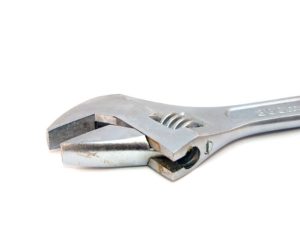
Open-End Wrenches
When you were growing up, you may have watched your dad or your mom repair your bicycle tire. Do you remember the tools they used? To remove the wheel, it was most likely an open-end wrench. Also most likely, two wrenches were used. One was used to hold the bolt steady (not turning) and one to turn the nut.
Open-end wrenches resemble a “U” on each end and each end is a different size. With each turn of the nut, the wrench is removed and re-positioned to turn the nut again. The “U” design allows the wrench slide into position around the nut or bolt. However, if the wrench isn’t properly fitted to the nut or bolt, the fitting can be damaged. These wrenches are available in Metric and SAE (Standard Automotive Engineers) measurement. SAE is the U.S. measuring system. Consequently, you may need a 5/16′ wrench (SAE) or an 8mm (Metric).

Box-End Wrenches
The box-end wrench is used when an open end-wrench cannot be slid into position. Where the open-end wrench has an opening to slide the wrench onto the nut or bolt, the box-end is closed The advantage of a box-end wrench over the open-end wrench is that the head grips the bolt or nut completely. This gives the wrench more leverage and has a lesser chance of slipping. These wrenches, like the open-end, also come in SAE and Metric sizes.

Combination Wrenches
These wrenches are very economical. One end is an open-end while the other is a box-end. With five combination wrenches, you actually have ten. Often, bicyclists keep one handy for quick fixes.
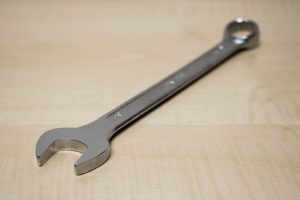
Socket Wrenches
Socket wrenches typically have a handle with a 90-degree ratchet. The ratchet, as with ratcheting screwdrivers, is type of gear mechanism that holds when going one direction and releases when going the other direction. You can tighten or loosen or bolt by setting the ratchet.
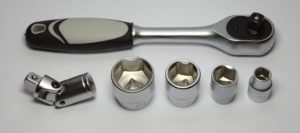
Purchase a socket wrench set and it will contain the handle and multiple sockets of different sizes. Again, this is a set that has SAE and Metric sizes. Small ratchets typically have a 1/4′ square nub that the sockets fit. Extenders are available for use with the handle and sockets for harder to reach places. When using a socket set, as with all wrenches, it is important to use the correct size. Be mindful that the ratchet can make it easy to twist off the head off of the bolt.
Helpful Hints:
Lubricants like WD-40, Liquid Wrench, or even spray brake cleaner can be used to loosen really tight nuts and bolts reducing the chance of damaging the nut or bolt or even removing the head of the bold.
Make sure to use the correct size. If the bolt or not requires a Metric wrench, use it instead of an SAE wrench. Not using the correct wrench can damage the nut or bolt.
When using any wrench, don’t push the tool. Instead, pull. Pushing the wrench can cause it to slip which can possibly cause injury to your hands or fingers and can damage the nut or bolt.
For information on what other tools to put in your toolbox, be sure to check out our tool list.
Like this article? The Lazy-Girl Guide to Life also has tips on how to run your household, manage your money and feed your family.

